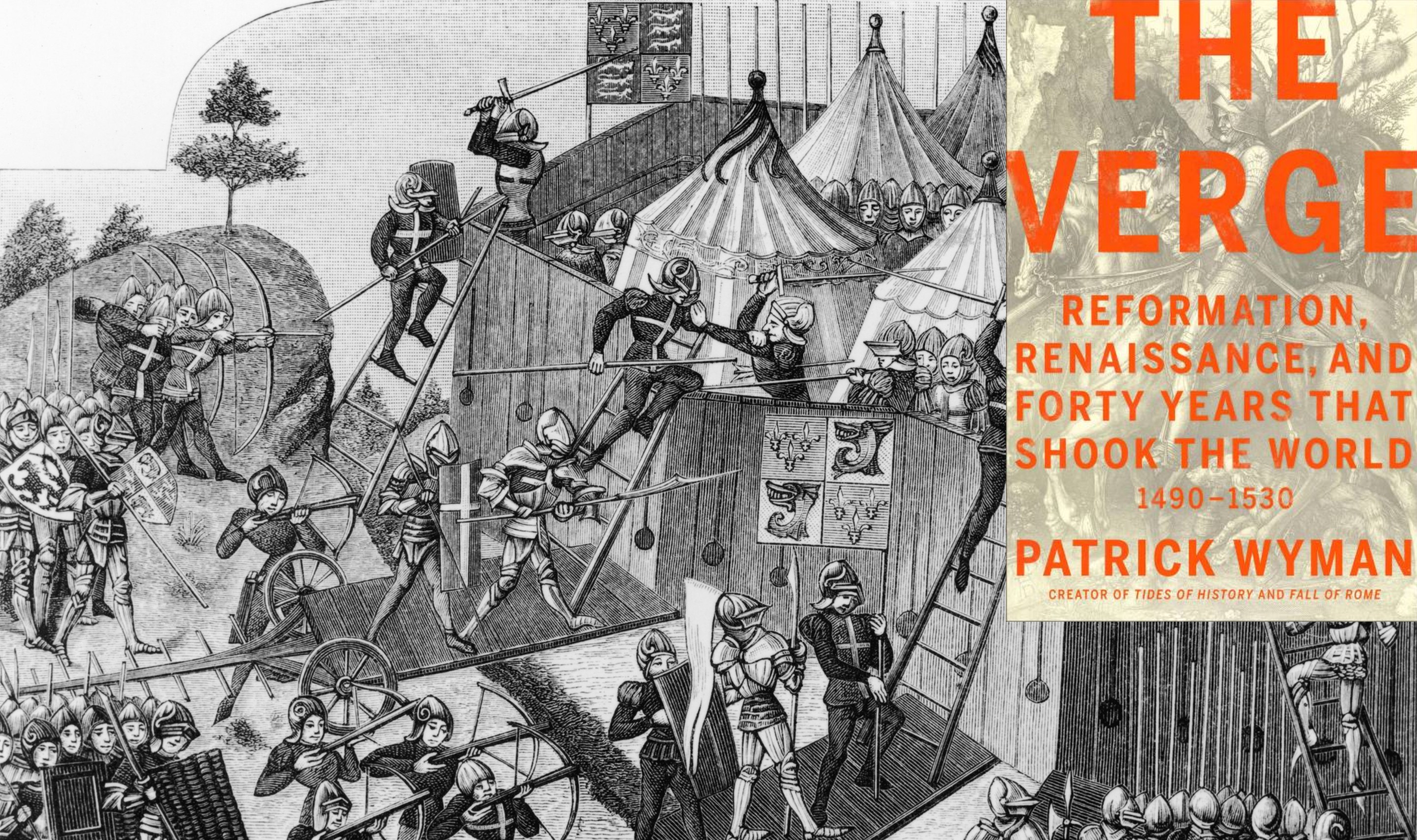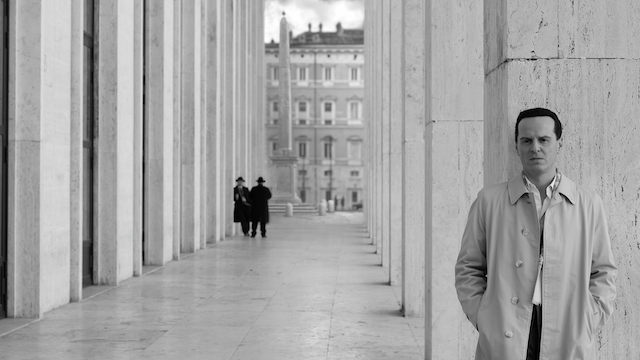Götz von Berlichingen Had A (Literal) Iron Fist And A Front-Row Seat To The Military Revolution
1:20 PM EDT on July 19, 2021

Image by Kean Collection/Getty Images
The following is an excerpt from The Verge: Reformation, Renaissance, and Forty Years that Shook the World, by Patrick Wyman. The book is currently available for pre-order.
June 1504, Landshut, Bavaria.
The rotten-egg stench of burnt gunpowder permeated the humid summer air, clashing with the earthy aroma of congealed sweat on unwashed bodies and the ordure of horses. The beasts neighed and nickered, but the clang of steel on steel, the sharp crack of arquebuses, the twang of crossbow strings loosing their bolts, and the booming roar of cannon drowned them out. Above the din, men’s cries carried all the way to the town of Landshut and the castle walls rising in the distance beyond. Summer sunlight glinted off the polished steel plates of men-at-arms on horseback as they drove their lances down into the droves of enemy foot soldiers sheltering in a shallow ditch. Long pikes jabbed upward and arquebus muzzles exploded in flame and drifting clouds of white smoke in response.
Driven back by the fierce defense, the men-at-arms spurred their horses and retreated while the clash continued in the open field. One of them raised the flat visor of his helmet and pushed it onto the back of his head. Sweat plastered thinning strands of blond hair to a high forehead and dripped down a bulbous nose. Only a few lines marked a face just reaching its mid-20s, but a lifetime of violence had long since rearranged its features with scars and that crooked, misshapen nose. Dents and scratches old and new marred his steel breastplate and helmet. A battered, well-used sword hung at his right side.
Having wiped the sweat of exertion from his eyes, he swung his visor back down and reentered the fight alongside the other men-at-arms, who thrusted with their lances as they tried to get over and around the ditch. The roar of cannon pierced the clangs and cries of the battle; lance held tightly in hand and close to his body, the soldier was readying himself from shoulder to fist for another thrust when a blast sounded across the battlefield, followed by a sudden, hideous crunch. The young man-at-arms felt a sudden pain in his right forearm and looked down through the narrow slit of his visor. His lance lay on the ground near his horse’s hooves, but he did not recall dropping it.
It took a moment to register that only a thin ribbon of mangled flesh was keeping his hand attached to what remained of his arm. The enemy cannonball had driven the pommel and crossbar of the sword deep into the meat of his forearm through the tiny gap between his steel gauntlet and the metal plates of his vambrace, nearly severing the limb.
The image seared itself into his brain. Many years in the future, long after blindness had taken his sight, Götz von Berlichingen had no trouble recalling every detail of that moment: the precise way in which the scales of his armor plate were bent around the edges, how the crossbar had lodged in his flesh, the way his hand dangled at an obscene angle from mere tissue.
Years of training, battle experience, and the onset of shock kept Berlichingen calm in the saddle as he turned his horse and galloped away from the skirmish. If the injury itself did not kill him, infection certainly would. But perhaps as a testament to his particular combination of relentless pugnacity and devilish luck, Berlichingen did not die. Following a protracted recovery, he replaced his mangled right hand with an iron prosthetic, determined to continue his life of scrapping, pillaging, feuding, and war for years to come.
Holy Roman Emperors would declare Götz of the Iron Hand—as he soon came to be known—both an outlaw and a valuable mercenary. A noble by birth, he would fight alongside peasants in one of the largest social revolts in European history. Johann Wolfgang von Goethe would find his memoir two centuries after his death and turn him into the hero of a famous play.
As a member of the lower nobility, Berlichingen was defined by both war and his broader role in society. Nobles fought for material rewards and for status. Yet as the 16th century dawned, gunpowder, rising states, and enormous influxes of capital were fundamentally changing the art of war. For people like Berlichingen, this Military Revolution was a world-upending sequence of events. What was a knight to do if any upstart artisan with an arquebus could blast through his fine, expensive armor and win the day? The freedom to defend one’s honor and status with private violence was a key facet of a knight’s identity; what freedom did he have if emperors and princes went around exerting their increasing authority and making war their public business?
Most nobles made their peace with this new state of affairs. The day of the armored knight dominating the battlefield may have come to an end, if it ever actually existed, but a knight with land and resources could still make war his profession. After all, this was the great age of well-paid mercenary armies. All across Europe, knights and nobles transformed themselves from feudal warriors to military entrepreneurs. Credit and contracts, the bread and butter of European commercial society, were no less a part of the business of war than they were of banking, mining, or the wool trade.
The region of southern Germany that Götz von Berlichingen called home was a key epicenter of the business of war throughout this period. His extended family, friends, acquaintances, and rivals—knights and nobles all—dove headfirst into this world of military entrepreneurship. Berlichingen, however, did not embrace that path. He insisted on fighting his private wars and feuds, robbing merchants and quarreling with bishops and other knights, and repeatedly getting into trouble with authorities. His antics would result in his living 15 years under house arrest. And in the end, the growing war machine of the 16th century managed to pull in even this most hardheaded of soldiers. The old ways and the new met, clashed, and the new eventually emerged victorious.
Military Revolutions
Götz von Berlichingen’s life saw a deep, rapid, and fundamental transformation of warfare. Massed firepower rendered the armored knight obsolete; armies grew; and strategies and tactics that relied on these larger armies became infinitely more complex and ambitious. War took a greater and greater toll on society: More crops were burned, more villagers were slaughtered in senseless raids, more young men lay dead on battlefields, more wealth was squeezed to pay for the mounting costs, culminating in the decades-long calamity that was the Thirty Years’ War between 1618 and 1648. That conflict turned the entirety of central Europe into a burnt-over war zone, killing roughly 15 percent of the population in the region and becoming proportionately the most destructive conflict in European history. That was where the transformations of Berlichingen’s lifetime inevitably led. Gunpowder, the new fortifications built to withstand cannon after the 15th century, and the intertwined issues of the size of armies and the increasing scope of war combined to produce a rising chorus of tragedy.
These developments may have been less revolutionary than they seem, since all of them grew directly out of developments made between 1300 and 1500. War in the Middle Ages had not been stagnant. In fact, the stereotyped ideal of a feudal king calling on his vassals—armored knights all—to render him limited military service in return for land had long since been outmoded. All of the English armies of the Hundred Years’ War (1337–1453) were paid. Volleys of arrows from their longbowmen had ended the battlefield reign of aristocratic knights long before the first arquebus came out of a foundry. Cannon first appeared on battlefields in the middle of the 14th century, and by the middle of the fifteenth they had set the tone for siege warfare. King Charles VII’s artillery train shredded the final English army to bring the war to French soil in 1453. That same year, the Ottoman sultan Mehmet’s cannons blasted holes in Constantinople’s formerly impregnable, thousand-year-old walls. France finished its long war with England by employing a professional standing army built around companies of armored lancers and archers. The dukes of Burgundy followed suit, as did many of the Italian city states around this time. As the new century opened, most of the technologies and mechanisms of raising armies that would dominate the 1500s were already in place, and had been for some time.
The opening decades of the 16h century, however, brought a series of dramatic shifts. The preexisting technological shifts and logistical structures coalesced into a distinct method of waging war that revolved around pikes, handguns, artillery, and fortifications. Infantry did not immediately eclipse the armored man-at-arms on horseback, but the balance of numbers—and tactical importance—did appreciably move toward foot soldiers. All of this drove a massive, rapid increase in the scale, intensity, and cost of war. And Götz von Berlichingen had a front-row seat.
The Italian Wars, the defining conflict of the coming century, erupted in 1494 when King Charles VIII of France crossed the Alps. The 23-year-old king, hungry for land and glory, marched south with an army full of professional lancers, Swiss mercenary pikemen, and the largest artillery train Italy had ever seen. He rampaged his way to the throne of the Kingdom of Naples, forever changing European power politics in the process. The following year, King Ferdinand of Aragon entered the war, adding a rising Spain to the conflict. Then Holy Roman Emperor Maximilian opted to get involved, hoping to win some ripe territorial prizes for himself. The Republic of Venice added itself to a coalition opposed to Charles’s expansive Italian ambitions. Both sides tried to entice King Henry VII of England to join them.
The stage was set for a vast, interlocking, almost constant state of conflict that would last for decades. It began with Charles VIII and his designs on Naples but soon morphed into a dynastic and geopolitical conflagration that engulfed Europe entirely. From the moors of Northumberland to the rocky coast of Granada, from the peaks of the Pyrenees to the vast flats of the Hungarian Plain, army after army set forth to fight battles, lay sieges, and immiserate those villagers and townspeople who had the misfortune of lying in their path. Over the next 65 years (1494–1559), the longest period of general peace lasted just five years. Even outside the great power conflicts of western Europe, wars large and small were easy to find: campaigns against the Ottomans in Hungary and the Mediterranean; the incessant raids by Barbary corsairs on the coasts of Italy and Spain; the smaller wars of princes, nobles, and cities against one another. The last of these was Berlichingen’s particular specialty. While he was not a direct participant in the Italian Wars, his social world was full of people whose lives and business interests revolved around those enormous conflicts.
Incessant battlefield slaughter and grinding sieges created fertile ground for military entrepreneurship and innovation. The riches of kings, emperors, and princes flowed into the pockets of recruiting captains, mercenary soldiers, cannon founders, armorers, suppliers, and the bankers who transferred the funds. The actual amounts of money involved always fell short of what the contracts promised, but the sums were nonetheless considerable, requiring the tight squeezing of rulers’ fiscal resources to even come close to making good. The armies grew larger and stuck around longer, and the offseasons were fewer and further between. War had become a business like any other. This, more than any technological change, was the essence of the Military Revolution.
Swimming Against the Tide
This era produced great captains who assembled thousands of mercenaries on contract for kings and emperors. Innovators experimented with new battlefield formations that maximized the possibilities of gunpowder handguns and cannon, while commanders developed grand strategies and visionary tactical plans for handling soldiers in clashes that dwarfed those of the previous century.
Götz von Berlichingen was not one of them. Even well into his stout, potbellied 60s, he remained a man-at-arms, riding off to war on horseback, wearing a full suit of steel plate and carrying a sword and lance. His wars were mostly small scale feuds between cities and noblemen rather than the epic confrontations of dynastic states.
But Berlichingen was still a part of the Military Revolution. War for honor and profit was his occupation from childhood to retirement, and violence was a fundamental part of his identity. He continued to raise troops on contract in the service of lords, princes, and emperors. His family, friends, and rivals were all in the business of military contracting, some on a truly enormous scale. As has been true throughout history, war is less heroic battles and more a drudgery of marching, raiding, and skirmishing, all of which Berlichingen highlighted at length in his memoir. The sound of gunfire, that haunting melody of new warfare, often rang in his ears. There is no better symbol of the Military Revolution than Berlichingen’s defining injury: A cannonball destroyed his strong right arm, the sword-swinging, lance-holding means of enforcing his knightly prowess.
Berlichingen’s stubborn insistence on doing things his way was in direct contravention of the rising tide of state power that surrounded him. Feuding lay at the core of his occupation and self image, and his dozens of petty wars feature prominently in his long-winded, self-congratulatory memoir; the practice was on its way out, however, and Berlichingen was a member of the last generation to make their living in that fashion. Princes and emperors squeezed the political and legal systems of their respective capacities for private war, eventually managing to pull men like Berlichingen into their military machines. Berlichingen’s final campaigns were on contract, as a part of an army led by the Holy Roman Emperor Charles V. Even a maverick, independent killer like Berlichingen eventually succumbed to the trends of his age.
The Life of a Noble
Despite his distinctive iron hand and boastful memoir, Götz (short for Gottfried) von Berlichingen was a deeply ordinary member of his social class. Born around 1480 in what is now Baden-Württemberg, approximately 80 miles west of Nuremberg, he was the youngest of eight surviving children born to the minor nobleman Kilian von Berlichingen. With three older brothers, Gottfried had no chance of inheriting the family’s eponymously named estate of Berlichingen. He would have to make his own way in the world, and that way was built on violence.
“I have verily heard from my blessed father and mother, and also from my brothers and sisters who were older than me, as well as from old servants and maidservants who were in service with them, that I was a wondrous young boy,” his memoir begins, “and that I already showed and behaved in my childhood that many people realized and deduced that I would shape into a warring man (kriegsman) or horseman (reuterßman).”
If we are to believe the author—and there is no reason to doubt him—war was his calling from an early age, and everyone around him knew it. His childhood involved riding, hunting, swordsmanship, working with the lance, and all the other regular activities that prepared him for a life of warfare. At fifteen, he became a page and groom to his cousin, Conrad von Berlichingen, a knight of some standing, and served him until he died several years later. Berlichingen’s first war came at age 18, after Conrad’s death, when he joined up as a page in the Holy Roman Emperor Maximilian’s campaign to retake Burgundy from France in 1498. The campaign was a failure—Berlichingen remembered it mostly for the fact that his employer gave him a fine French coat as payment—but it was his first taste of real war. He saw armored lancers die of heatstroke, and he broke into castles and burned a village, experiences that he would repeat many times over the next six decades.
Violence was a profoundly fundamental part of Berlichingen’s identity. During an intense altercation with a Polish servant—he had mussed up the Pole’s finely coiffed hair—Berlichingen hit him over the head with a short sword. He was around 18 at the time. That same year, he and a friend brawled with a trumpeter, an incident that left a long, deep gash on his head. This sort of thing was a constant feature of Berlichingen’s life, and he tells many stories of this kind. That he felt these kinds of incidents were worth narrating—and one can only imagine how many he left out—highlights the fact that his instinctive reaction to any sort of challenge to his honor or status was violence.
This was typical for men of Berlichingen’s social class. In fact, it was the essence of chivalry. The modern sense of the term, as a code of behavior for dashing, honorable knights, bears little resemblance to its medieval definition, the core of which was violence. Knights and nobles justified their existence as a social elite by fighting for acceptable causes; religious wars against Muslims or heretics were best, but a clever knight could turn any sort of conflict into a soul-burnishing positive. Knights were famously sensitive about their social standing, and an insult—from a Polish servant or a wayward trumpeter, for example—necessitated an aggressive response; otherwise, the offended party could hardly call himself a knight at all. Vengeance, anger, and drawn weapons were all basic parts of the knight’s experience and emotional tool kit.
In 1500, following a campaign against the rising Swiss Confederation and their fearsome pikemen, a twenty-something Berlichingen “donned armor for the first time” and from thenceforth considered himself a professional man-at-arms. In the parlance of the times, “knight” was a social rank; “man-at-arms” was a skill set and an occupation. It referred to a man who typically fought on horseback with lance and sword, clad from head to toe in expensive plate armor. Even around 1500, when Berlichngen took up this path for good, the man-at-arms was hardly outmoded on European battlefields. Nor was chivalry. It was not dying out, despite technological and logistical shifts in the practice of war. In fact, chivalry had enmeshed itself into the mutating ethos of a noble class that wanted to maintain its place in the world of war despite those ongoing changes.
Honorable combat was all well and good, and Berlichingen’s memoir is full of these encounters. He recounts charging a Wagenburg—a fortified ring of wagons bristling with artillery—and holding open a gap in the lines long enough for his compatriots to get through despite being wounded and his horse dying under him. This kind of thing was the bread and butter of knightly life, but Berlichingen also casually mentions the looting and burning of a church, killing peasants in the course of a feud, serving with a band of robber-knights, and other incidents that would seem at odds with our idea of chivalry. Those are modern misconceptions, though. For men like Berlichingen, there was no such contradiction.
Nor was there any contradiction between payment and honorable war; very much the opposite. This was a long way from the centuries-out-of-date idea of land for military service. Cash was a perfectly fine reward, as when Berlichingen and his brother Philip received 2,000 gulden—a hefty sum—from Margrave Friedrich of Brandenburg in return for their services as men-at-arms in one of his many wars. Money could purchase loyalty, as Friedrich well understood.
It was only a short jump from payment for military service to contracting the military service of others for pay. Showing up with a horse, armor, and weapons had for some time been insufficient to meet the rising military needs of princes, kings, and emperors, and the sharp uptick in war at the beginning of the 16th century supercharged what was already an ongoing process. Nobles like Berlichingen still saw war as their business, and military entrepreneurship—recruiting, organizing, and leading units of hired soldiers—offered a viable continuation of their social role.
This was Berlichingen’s milieu. He was not a major military contractor himself early in life—he and one of his brothers made up two of the three men-at-arms in the first contract he mentions in his memoir—but he was surrounded by major players in that field. He had a loose concept of kinship; by virtue of his six married siblings (the seventh, Kilian, was a Teutonic Knight and thus celibate), Berlichingen was related to practically every other nobleman within a hundred-mile radius. As with the Augsburg merchants, business and family went hand in hand. There was always a relative recruiting for a war, like his cousins Neidhard, Götz (a different Götz—it was a common name), and Sigmund von Thüngen, who hired him as a squad leader in a company of man-at-arms for the Landshut campaign in which he lost his forearm. Two of his brothers were fighting on the opposing side, as it happened, and Berlichingen would have preferred to fight with them. This was the reality of noble life at the dawn of the 16th century: It was just business.
Contract Warfare
“Peace, peace,” a man-at-arms shouted, struggling to make his voice heard over the din of armor and horse tack as dozens of riders pulled up their mounts. The men surrounded a pair of figures locked together and exchanging furious blows among the leaves and dirt of the forest floor. One of them wound up on top, drew back a solid iron hand, and repeatedly struck the other in the face, cracking his nose and sending blood and teeth flying. “Peace!” shouted the man-at-arms again, emphasizing his point with a loaded crossbow. His riders followed suit.
The man with the iron hand ceased his pummeling and looked up. “He was beating my captives,” said Berlichingen, gesturing toward a pair of disheveled peasants leaning against a tree. “If you put your hands on me, I’ll break them,” he continued, but did not protest at traveling along with the group of riders when they went to an inn for a drink. Berlichingen was now technically a prisoner, but that was nothing to worry about or be ashamed of: It was something of an occupational hazard, and easily reversed. His captor and drinking buddy—“we drank and were merry,” Berlichingen says—was an acquaintance by the name of Georg von Frundsberg (1473–1527), a noble and man-at-arms of some reputation. They had fought in the Landshut War and taken plunder together, and whether it was the drink, their shared experience of war, or their family connection (he called Berlichingen “brother-in-law”), the two parted on exceedingly friendly terms.
It is not hard to understand why they got along so well, swilling beer and wine in a crowded inn and swapping stories of feuds, friends, and battles. They had a great deal in common on this occasion in 1504 or 1505, when they crossed paths at the brawl and reconvened at the inn: family, for one, and the same violently chivalric worldview. They came from the same part of Germany, within a few dozen miles of each other, and were nobles of roughly the same social rank. Above all, they shared an occupation. Both were soldiers-for-hire and had presumably been on different sides of whatever petty war had led them to that forest.
Even at this early date, however, they were on opposite ends of the business spectrum. Frundsberg showed up to capture Berlichingen with 20 or 30 men-at-arms; that was a small force for him at the time, and he was used to raising much bigger companies. By the end of his life, Frundsberg would become one of the largest-scale contractors and commanders in an age of drastically increasing military scale. His last contract, in 1527, accounted for the eye-popping total of 16,000 mercenary infantry. When he did not receive the money to pay them, they went on to sack Rome and imprison the pope himself.
Frundsberg was one of the key figures in the transformation of war in this period and an innovator in scale, but he was heir to a tradition of contract warfare with deep roots in the preceding centuries. That was the norm throughout Europe by the time Berlichingen and Georg von Frundsberg entered the business, a centuries-long evolution of military and commercial institutions toward a common form. The precise term for such an agreement varied from place to place. In England, the contract was an indenture; in France, a lettre de revenue; in Italy, a condotta; and in Germany, a Bestallung. The responsibilities of the contractor and the formality of the deal varied, as well. In Italy, the most deeply commercialized and contractually sophisticated part of Europe, a condotta was a precise and complex piece of business. While Germany was a commercially advanced region, a Bestallung was generally quite informal up until around 1500—it might not even take written form, but instead consist of a verbal or even implicit agreement. In England, captains tasked with recruiting soldiers usually received cash advances from their employer—usually the king or a great nobleman—which they then paid out. In Germany, more often hiring came at the recruiter’s own expense and risk, turning the military entrepreneur into both a creditor and a soldier.
Two types of military contracting existed side by side. In the first, a captain recruited or acquired soldiers, formed a company, and then went looking for a contract. These could be short-term assemblages put together for a single campaign, like those in which Berlichingen often found himself as a young man: His Thüngen cousins, presumably subcontractors for the commander, pulled him into just such an ad hoc arrangement for the Bavarian war that took his arm. By contrast, the Great Companies of 14th-century Italy, like those of the famous mercenary John Hawkwood, were reasonably permanent. They stuck around year after year, drilling, training, and drawing wages while staying ready for the next campaign. Permanence had also been the norm for the ambitious Italian condottieri of the first half of the 15th century, like Muzio Attendolo Sforza and Braccio da Montone, whose soldiers followed them from employer to employer.
In the second major type of military contracting, an employer went looking for soldiers, or a person to find soldiers, rather than the other way around. This was the norm in France and England especially. English lords were particularly fond of “retaining,” in which they made regular cash payments to men who in times of war signed onto formal indentures and hired others on their behalf. There was a rough German equivalent that turned the retaining middleman into a figure called a Diener von Hausaus. This form of retention produced the armies that fought the Wars of the Roses, as well as every other late medieval army in England. By 1500, this second form was either the norm all across Europe or becoming so: There were no permanent bodies of soldiers that were not directly contracted to an employing state.
In effect, Europe’s military systems had converged on a common arrangement around 1500. A captain, practically always a nobleman, received a contract from an employer (prince, king, or emperor) to recruit a set number of soldiers, and then went about fulfilling the order. The differences lay only in the nature of the recruiter’s connection to his employer and either the provision or lack of an advance payment from employer to recruiter. The system relied on a large, sophisticated, contractually based, and geographically widespread market for mercenaries. War was private business, mostly subcontracted from rulers to entrepreneurs, rather than a public state function built on standing armies. The standing armies that did exist may have been the core of a ruler’s military capabilities, as they were in France, but filling out an army for a serious campaign required the services of hired professionals.
Berlichingen came into adulthood and set off on his first military campaigns surrounded by this environment of contractual combat and military entrepreneurship. When Georg von Frundsberg was not capturing Berlichingen in a forest, he was mostly off recruiting soldiers by the hundreds and thousands to fight the emperor Maximilian’s many wars. Berlichingen’s business, meanwhile, was on a smaller scale, but followed the same pattern: He recruited and led 150 men-at-arms for a feud in 1514 and 70 or 80 on behalf of his brother-in-law the following year. In any case, an extremely large force was nothing more than an aggregate of smaller ones, recruited by the dozen, 100, or 500, a main recruiter subcontracting to lesser captains. For both men, with their various scales of operation, credit was key to the arrangement. A nobleman’s land and estates, and his reputation as a soldier, were surety for payment. Why would a mercenary man-at-arms, or a group of foot soldiers, take contract with Frundsberg or Berlichingen? Because they believed the two men were good for the money they had been promised. That was credit, both literal and figurative.
Both men’s chivalric upbringing made this environment easy to navigate. War was both honorable and suitable for a nobleman of their ilk and an often lucrative occupation that shared much in common with the mercantile activities common to their south German homeland. Everybody, whether a weaver or a banker or a soldier, understood contracts and the exchange of money for services. War was no different; it was better, in fact, because it still carried a whiff of the old nobility.
Berlichingen’s memoir focuses far more on violence, its uses, and its benefits than the contractual basis for organized conflict, but that is not because he was oblivious to it; very much the opposite. Instead, it is because he was so steeped in the concept of military service for material gain that it was simply part of the background noise of his life. It was not necessary or interesting to talk about how he joined a company of mercenary knights, or the agreements, written or verbal, he used when assembling a company of 100 men-at-arms for the Holy Roman Emperor Charles V. Everybody in Berlichingen’s world already knew.
If you liked what you read, check out the rest of Patrick's new book The Verge: Reformation, Renaissance, and Forty Years that Shook the World, available here. Patrick also read the audiobook of The Verge, available here, which he recorded in the same booth where Lil Wayne recorded much of Tha Carter III.
If you liked this blog, please share it! Your referrals help Defector reach new readers, and those new readers always get a few free blogs before encountering our paywall.
Read More:
Stay in touch
Sign up for our free newsletter




